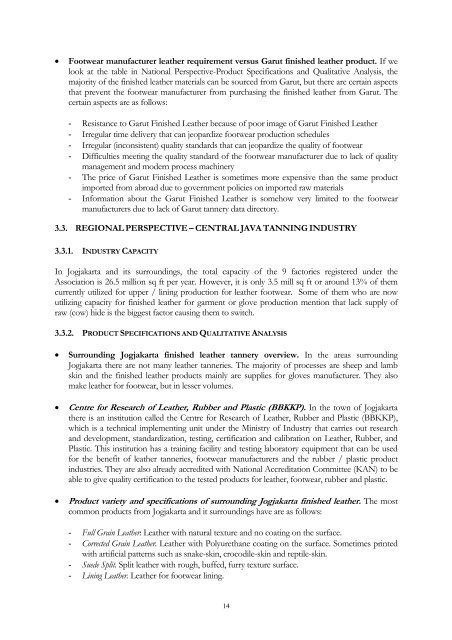ACCESS OF FOOTWEAR RAW MATERIAL INPUTS - part - USAid
ACCESS OF FOOTWEAR RAW MATERIAL INPUTS - part - USAid
ACCESS OF FOOTWEAR RAW MATERIAL INPUTS - part - USAid
You also want an ePaper? Increase the reach of your titles
YUMPU automatically turns print PDFs into web optimized ePapers that Google loves.
• Footwear manufacturer leather requirement versus Garut finished leather product. If we<br />
look at the table in National Perspective-Product Specifications and Qualitative Analysis, the<br />
majority of the finished leather materials can be sourced from Garut, but there are certain aspects<br />
that prevent the footwear manufacturer from purchasing the finished leather from Garut. The<br />
certain aspects are as follows:<br />
- Resistance to Garut Finished Leather because of poor image of Garut Finished Leather<br />
- Irregular time delivery that can jeopardize footwear production schedules<br />
- Irregular (inconsistent) quality standards that can jeopardize the quality of footwear<br />
- Difficulties meeting the quality standard of the footwear manufacturer due to lack of quality<br />
management and modern process machinery<br />
- The price of Garut Finished Leather is sometimes more expensive than the same product<br />
imported from abroad due to government policies on imported raw materials<br />
- Information about the Garut Finished Leather is somehow very limited to the footwear<br />
manufacturers due to lack of Garut tannery data directory.<br />
3.3. REGIONAL PERSPECTIVE – CENTRAL JAVA TANNING INDUSTRY<br />
3.3.1. INDUSTRY CAPACITY<br />
In Jogjakarta and its surroundings, the total capacity of the 9 factories registered under the<br />
Association is 26.5 million sq ft per year. However, it is only 3.5 mill sq ft or around 13% of them<br />
currently utilized for upper / lining production for leather footwear. Some of them who are now<br />
utilizing capacity for finished leather for garment or glove production mention that lack supply of<br />
raw (cow) hide is the biggest factor causing them to switch.<br />
3.3.2. PRODUCT SPECIFICATIONS AND QUALITATIVE ANALYSIS<br />
• Surrounding Jogjakarta finished leather tannery overview. In the areas surrounding<br />
Jogjakarta there are not many leather tanneries. The majority of processes are sheep and lamb<br />
skin and the finished leather products mainly are supplies for gloves manufacturer. They also<br />
make leather for footwear, but in lesser volumes.<br />
• Centre for Research of Leather, Rubber and Plastic (BBKKP). In the town of Jogjakarta<br />
there is an institution called the Centre for Research of Leather, Rubber and Plastic (BBKKP),<br />
which is a technical implementing unit under the Ministry of Industry that carries out research<br />
and development, standardization, testing, certification and calibration on Leather, Rubber, and<br />
Plastic. This institution has a training facility and testing laboratory equipment that can be used<br />
for the benefit of leather tanneries, footwear manufacturers and the rubber / plastic product<br />
industries. They are also already accredited with National Accreditation Committee (KAN) to be<br />
able to give quality certification to the tested products for leather, footwear, rubber and plastic.<br />
• Product variety and specifications of surrounding Jogjakarta finished leather. The most<br />
common products from Jogjakarta and it surroundings have are as follows:<br />
- Full Grain Leather: Leather with natural texture and no coating on the surface.<br />
- Corrected Grain Leather. Leather with Polyurethane coating on the surface. Sometimes printed<br />
with artificial patterns such as snake-skin, crocodile-skin and reptile-skin.<br />
- Suede Split. Split leather with rough, buffed, furry texture surface.<br />
- Lining Leather. Leather for footwear lining.<br />
14

















